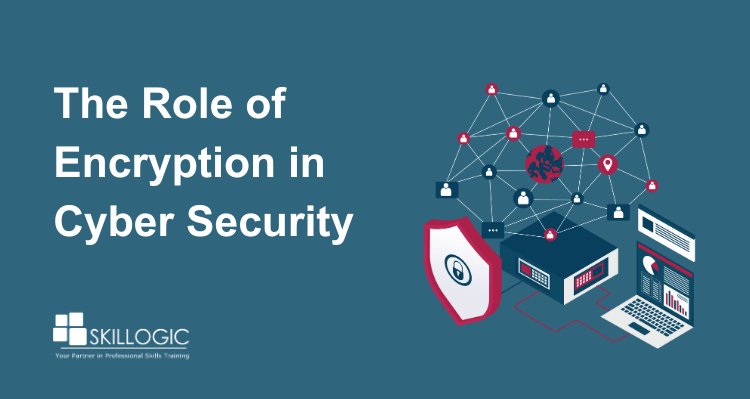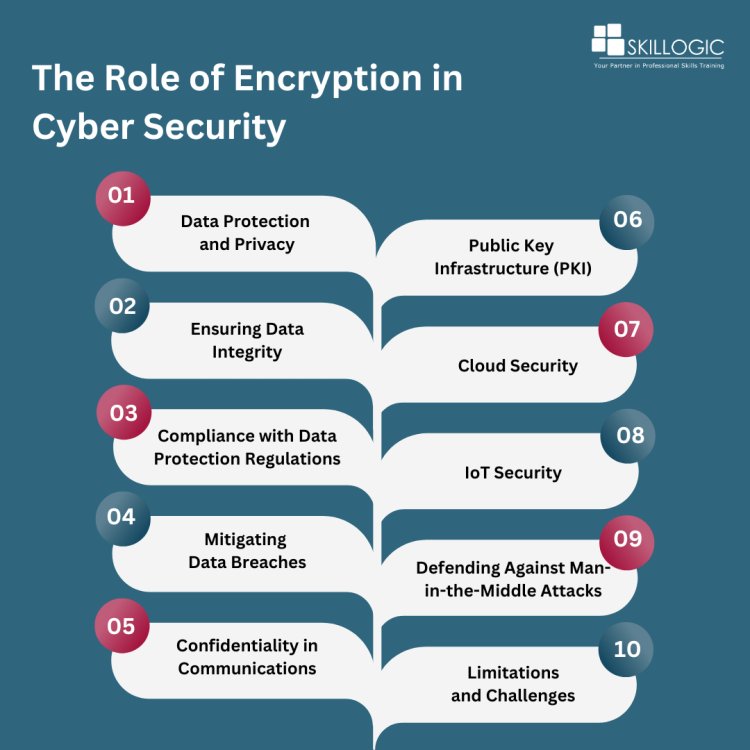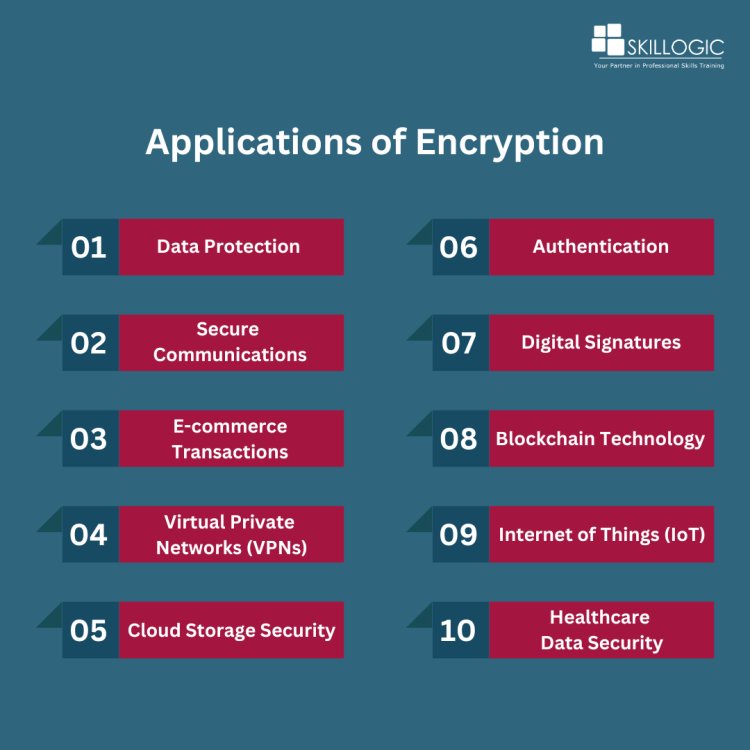The Role of Encryption in Cyber Security

In an era where digital interactions are the norm, the significance of Cyber Security cannot be overstated. From online banking to social media, our daily lives increasingly depend on secure digital platforms. Every interaction we have online involves a degree of risk, from data breaches to identity theft. Thus, ensuring the safety of our personal and sensitive information is paramount.
Encryption plays a pivotal role in this realm, acting as a shield against unauthorized access and cyber threats. It transforms readable data into a coded format, making it inaccessible without a specific key. This process not only protects information but also builds trust among users, ensuring that their data remains private and secure. As such, understanding encryption and its applications is crucial for anyone interested in pursuing a top Cyber Security course or seeking Cyber Security training.
What is Encryption?
Encryption is the process of converting plaintext into ciphertext, which is an unreadable format. This transformation ensures that only authorized users can access the original data. The significance of encryption lies in its ability to protect sensitive information from cyber threats, data breaches, and unauthorized access.
Types of Encryption
There are primarily two types of encryption: symmetric encryption and asymmetric encryption.
- Symmetric Encryption: This method uses a single key for both encryption and decryption. Both the sender and receiver must have the same key to access the data. It is generally faster and more efficient for processing large volumes of data. Examples include the Advanced Encryption Standard (AES) and Data Encryption Standard (DES).
- Asymmetric Encryption: Also known as public-key cryptography, this method uses two keys: a public key for encryption and a private key for decryption. This ensures that even if the public key is shared widely, only the holder of the private key can decrypt the information. Popular asymmetric encryption methods include RSA (Rivest-Shamir-Adleman) and ECC (Elliptic Curve Cryptography).
Understanding these types of encryption is crucial for anyone pursuing a top Cyber Security course or considering Cyber Security training. Each type has its unique applications, benefits, and limitations, influencing how organizations implement encryption to protect their data.
Refer these articles:
- 10 Essential Cyber Security Tools for Beginners
- Cyber security vs. Information Security
- Cyber Security for Small Businesses

The Role of Encryption in Cyber Security
Encryption plays a crucial role in modern Cyber Security by protecting sensitive data from unauthorized access, ensuring privacy, and safeguarding the integrity of communications. It is one of the most effective tools in the fight against cyber threats, ensuring that even if data is intercepted or accessed, it remains unreadable without the proper decryption key. Here's a closer look at how encryption contributes to Cyber Security:
1. Data Protection and Privacy
- Data-at-Rest Encryption: Encryption protects stored data (on servers, databases, devices, or the cloud) by transforming it into an unreadable format. Even if attackers gain access to encrypted data, they cannot interpret or use it without the decryption key.
- Data-in-Transit Encryption: During transmission (e.g., over the internet, internal networks, or between devices), encryption ensures that intercepted communications remain confidential. Technologies like Transport Layer Security (TLS) and Secure Sockets Layer (SSL) encrypt data as it moves across networks.
Sensitive Data Protection: Encryption is particularly critical for safeguarding personally identifiable information (PII), financial details, and intellectual property from unauthorized access.
2. Ensuring Data Integrity
- Protection Against Data Tampering: Encryption can help verify the integrity of data. For example, hashing algorithms, often used in conjunction with encryption, allow for detection of any changes or tampering in the transmitted or stored data. If the data is altered, the hash value will change, flagging potential tampering.
- Secure Authentication: Many encryption protocols support secure authentication processes. For example, digital signatures rely on public-key encryption to verify the sender's identity and ensure that the message hasn’t been altered in transit.
3. Compliance with Data Protection Regulations
- Regulatory Requirements: Many data protection laws and regulations (e.g., GDPR, HIPAA, CCPA) mandate encryption to protect sensitive personal information. Organizations can face severe penalties for failing to encrypt data, particularly if a breach occurs.
- Meeting Industry Standards: Encryption is also a key requirement for compliance with industry standards such as the Payment Card Industry Data Security Standard (PCI DSS) for securing payment data.
4. Mitigating Data Breaches
- Minimizing the Impact of Breaches: In the event of a data breach, encryption ensures that even if an attacker gains access to sensitive data, it remains unreadable and unusable without the correct decryption keys. This limits the potential damage caused by the breach.
- Ransomware Defense: Encryption can play a defensive role against ransomware attacks. By encrypting critical data, organizations can make it more challenging for ransomware to alter or lock it, while keeping accessible backup versions safe from tampering.
5. Confidentiality in Communications
- Encrypted Messaging: Platforms like WhatsApp and Signal use end-to-end encryption (E2EE) to ensure that only the sender and the intended recipient can access the content of communications. This protects sensitive conversations from interception by third parties, hackers, or even service providers.
- Virtual Private Networks (VPNs): VPNs use encryption to secure the connection between a user and the internet, ensuring that any data transmitted across this channel remains private, even when using public or untrusted networks.
6. Public Key Infrastructure (PKI)
- Asymmetric Encryption: PKI is a foundational element of secure online communications. It uses a pair of public and private keys for encryption and decryption, facilitating secure email communication, digital signatures, and certificate-based authentication.
- Digital Certificates: PKI underpins the use of digital certificates, which are used to authenticate users, systems, and devices. This ensures secure connections between systems and verifies the legitimacy of websites (through HTTPS) and software.
7. Cloud Security
- Encryption in Cloud Services: As more organizations migrate data to the cloud, encryption becomes vital for protecting this data from unauthorized access. Cloud providers offer encryption for both data-at-rest and data-in-transit, and clients can often manage their own encryption keys for additional control.
- Zero Trust Model: Encryption supports the "zero trust" security model, where no entity (inside or outside the network) is trusted by default. Encryption ensures that even within cloud environments, data is compartmentalized and only accessible by authorized users.
8. IoT Security
- Device Encryption: The increasing number of Internet of Things (IoT) devices creates new entry points for cyberattacks. Encryption helps protect the data exchanged between IoT devices and central systems, ensuring that sensitive information collected by these devices remains secure.
- Securing Communication Channels: Encryption also ensures the secure transmission of data across IoT networks, mitigating risks such as man-in-the-middle (MITM) attacks or data theft during transmission.
9. Defending Against Man-in-the-Middle Attacks
- Encrypted Communications: Encryption is a primary defense mechanism against man-in-the-middle (MITM) attacks, where attackers intercept and potentially alter communications. Protocols like HTTPS and TLS encrypt the communication channel between users and websites, protecting sensitive information such as login credentials, personal data, and payment details.
10. Limitations and Challenges
- Key Management: Effective encryption depends on proper key management. If encryption keys are poorly protected, they can become a single point of failure. Secure key generation, distribution, and storage are crucial for encryption success.
- Performance Overhead: Encryption, especially with strong algorithms, can introduce computational overhead. Organizations must balance performance and security, optimizing their systems to handle encrypted workloads efficiently.
- Insider Threats: Encryption does not protect against insiders who have access to decryption keys. Strong access controls and monitoring are required to mitigate this risk.
Encryption plays a pivotal role in creating a secure environment, which is why it's a fundamental topic in any cyber security certification course.
Refer these articles:
- Cybersecurity Career Scope in 2024
- How to Become a Cyber Security Expert in India
- Cyber Security Course Fee in India

Applications of Encryption: Beyond Just Data Security
Encryption is not limited to protecting personal information; it has widespread applications across various sectors. Understanding these applications can help individuals appreciate the broader implications of encryption in today’s digital landscape.
- Data Protection: Encryption keeps sensitive data safe whether it's stored on a device or being sent somewhere, preventing unauthorized access and data breaches.
- Secure Communications: Email services, messaging apps, and voice calls use encryption to protect messages and calls, ensuring that only the intended recipients can read or hear them.
- E-commerce Transactions: Online shopping sites use encryption to secure customers' payment details and personal information during transactions, making online shopping safe.
- Virtual Private Networks (VPNs): VPNs encrypt your internet traffic, creating secure connections to remote networks and protecting your online activities from prying eyes.
- Cloud Storage Security: Many cloud storage services encrypt data before it's uploaded, so only authorized users can access it, even if the data is stored on third-party servers.
- Authentication: Encryption helps keep user credentials safe through methods like password hashing and tokenization, making it harder for unauthorized people to gain access.
- Digital Signatures: Encryption is used to confirm the authenticity and integrity of digital messages or documents, ensuring they haven't been changed during transmission.
- Blockchain Technology: Cryptographic encryption secures transactions and ensures the integrity of data in blockchain systems, supporting secure decentralized applications.
- Internet of Things (IoT): Encryption protects the data sent between IoT devices and servers, keeping sensitive information safe in smart homes, healthcare devices, and more.
- Healthcare Data Security: Encryption protects sensitive patient information and helps meet regulations like HIPAA by securing health records and communications in healthcare systems.
Through these applications, it is clear that encryption extends beyond data security; it is a fundamental component of trust and integrity across various industries.
Challenges and Limitations of Encryption: Navigating the Complexities
Despite its advantages, encryption is not without challenges. Understanding these limitations is crucial for effectively implementing encryption strategies.
Key Management
One of the significant challenges of encryption is key management. In symmetric encryption, the same key is used for both encryption and decryption, which means it must be shared securely between parties. If the key is lost or compromised, the encrypted data becomes inaccessible. As a result, organizations must invest in secure key management solutions to mitigate this risk.
Performance Impact
Encryption can also introduce performance overhead. Encrypting and decrypting data requires computational resources, which can slow down processes, especially for large datasets. Organizations must balance the need for security with system performance to ensure that encryption does not hinder operations.
Regulatory Compliance
While encryption helps organizations comply with data protection regulations, it can also pose challenges. Different jurisdictions have varying encryption laws, making it essential for organizations to understand the legal landscape and ensure compliance across regions.
In conclusion, while encryption is a powerful tools for Cyber Security, organizations must navigate these challenges to maximize its effectiveness.
Refer these articles:
- Cyber Security Course Fees in Bangalore
- Cybersecurity Scope in Pune
- How to Become a Cyber Security Expert in Hyderabad
Encryption in Emerging Technologies: A Future-Proof Solution
As technology continues to evolve, so does the role of encryption. Emerging technologies such as cloud computing, the Internet of Things (IoT), and artificial intelligence (AI) present new challenges and opportunities for encryption.
Cloud Computing
With the rise of cloud computing, data is often stored off-site, increasing the need for encryption. Cloud service providers offer encryption services to protect data both at rest and in transit. Organizations must ensure that they implement strong encryption practices when migrating to the cloud to safeguard their data.
Internet of Things (IoT)
The IoT landscape is expanding rapidly, with devices ranging from smart home appliances to industrial sensors. Each connected device generates data that requires protection. Encryption plays a crucial role in securing IoT devices, ensuring that data transmitted between devices remains confidential and tamper-proof.
Artificial Intelligence (AI)
AI technologies often rely on vast amounts of data for training and analysis. Encryption can help protect sensitive data used in AI models, ensuring that privacy is maintained. As AI continues to develop, the need for secure data handling through encryption will become increasingly important.
By understanding the role of encryption in emerging technologies, organizations can better prepare for the future and implement effective security measures.
Best Practices for Implementing Encryption in Cyber Security: Ensuring Robust Security
Implementing encryption effectively requires adherence to best practices. Here are some guidelines to help organizations optimize their encryption strategies:
1. Assess Your Needs
Before implementing encryption, organizations should assess their specific security needs. Understanding the types of data that require protection will help in selecting the appropriate encryption methods.
2. Use Strong Encryption Standards
Organizations should adopt strong encryption standards to ensure the highest level of security. This includes using modern algorithms and key lengths that meet industry standards.
3. Regularly Update Keys
Regularly updating encryption keys is crucial for maintaining security. This practice helps protect against potential key compromises and ensures that data remains secure.
4. Train Employees
Employee training is essential for effective encryption implementation. Ensuring that staff understands the importance of cyber security and how to handle sensitive data can prevent accidental breaches.
5. Test Your Systems
Regular testing of encryption systems is necessary to identify vulnerabilities. Conducting penetration testing and vulnerability assessments can help organizations uncover potential weaknesses in their encryption strategies.
By following these best practices, organizations can establish a robust encryption framework that enhances their Cyber Security posture and safeguards sensitive data.
In summary, encryption is a cornerstone of contemporary Cyber Security. It safeguards sensitive information and maintains confidentiality, making it indispensable for fostering trust in our digital age. Gaining a solid understanding of encryption techniques and implementing effective strategies is essential for anyone looking to pursue a top Cyber Security course or engage in Cyber Security training.
At SKILLOGIC Institute, we recognize the growing significance of Cyber Security in today’s digital environment. Our Cyber Security Professional Plus Course is meticulously designed to equip learners with the necessary skills to tackle the unique security challenges encountered across various domains. This program is accredited by prestigious organizations such as IIFIS and NASSCOM FutureSkills and offers comprehensive training that includes real-time projects and dedicated practice labs. This hands-on approach ensures that participants acquire not only practical experience but also a deep understanding of how to protect systems from potential threats.
With a community of over 100,000 empowered learners, SKILLOGIC is committed to advancing careers in Cyber Security through top-notch education and practical expertise. Our emphasis on real-world applications and industry-recognized certifications makes us an ideal choice for professionals eager to excel in the ever-evolving field of Cyber Security. Join us to stay ahead in your career and contribute to safeguarding the future of technology.

0
271